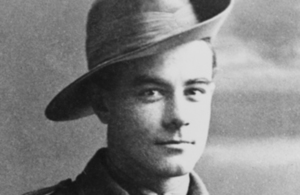WW1 Australian VC recipient Arthur Percy Sullivan
The story of Australian First World War Victoria Cross recipient Arthur Percy Sullivan.

Credit: Australian War Memorial A02497
66 men from Australia received the Victoria Cross, Britain’s highest award for gallantry, during the First World War. As part of the Centenary Commemorations the people of the United Kingdom marked their gratitude to those courageous men by presenting a bronze memorial plaque to their home country engraved with their names. The plaque is now displayed at the Australian War Memorial. This archive tells their stories.
Name: Arthur Percy Sullivan
DOB: 27 November 1896
Place of Birth: Prospect, South Australia
Date of Action: 10 August 1919
Place of Action: Sheika River, Archangel, Russia
Rank: Corporal
Regiment: 45th Battalion, Royal Fusiliers
Arthur Sullivan was born on 27 November 1896 in Prospect, South Australia, and worked as a bank clerk until enlisting in April 1918. He was too late for active service on the Western Front, so volunteered for the British North Russia Relief Force, as part of the Allied intervention in the Russian civil war.
Corporal Sullivan was awarded the Victoria Cross for his actions on 10 August 1919 at Sheika River, Archangel, in Russia. His citation reads:
For most conspicuous bravery and devotion to duty. The platoon to which he belonged, after fighting a rearguard covering action, had to cross the river by means of a narrow plank, and during the passage an officer and three men fell into a deep swamp. Without hesitation, under intense fire, Corporal Sullivan jumped into the river and rescued all four, bringing them out singly. But for this gallant action his comrades would undoubtedly have been drowned. It was a splendid example of heroism as all ranks were on the point of exhaustion and the enemy less than 100 yards distant.
Known as the “Shy VC”, Sullivan returned to Australia, resumed his job in a bank, married and raised a family. He died in 1937 as the result of a fall in London whilst attending the coronation of King George VI as a member of the Australian contingent. A plaque in his honour is on display on the railings of Wellington Barracks, London.